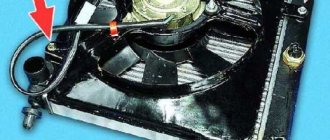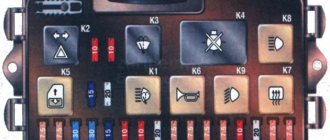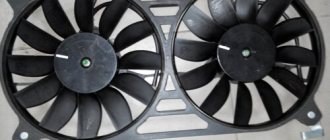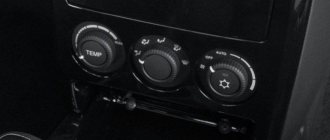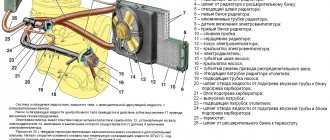On older domestic cars, the operation of the engine cooling system is quite simple. However, modern cars are equipped with an electric fan and various sensors, the operation of which is aimed at increasing the efficiency of engine cooling. Over time, malfunctions may occur in the operation of these elements, which affects the performance of the fan. Therefore, car owners have to deal with possible problems on their own or contact a specialized service.
- Lack of fluid in the system
- Sensor short circuit
Video: checking the fan switch sensor
- When is it advisable to repair it yourself and in the service?
Video: solving the problem of a constantly running fan
- Table: cost of repairing the cooling system with your own hands and in the service
Expert answer
On the VAZ-2115 that you had, the ECU (electronic engine control unit) most likely no longer worked correctly. By resetting it, you were essentially removing the terminal from the battery. Try doing the same now. Disconnect the battery terminal for a couple of minutes, then look at the situation.
If this does not help, then the problem is already in the technical part.
- First, check the connector on the thermostat; it may be poorly secured, and the data coming from the temperature sensor is not correct. This happens when routine maintenance is carried out, for example TO-1, TO-2. Most likely, when replacing the air filter, a bad contact occurred.
- Remove the temperature sensor and check its operation. Operating resistance 70 Ohm + 2% at 130 °C, and 100700 Ohm ± 2% at -40 °C.
Coolant temperature sensor
If possible, take a known-good sensor “for testing.”
Temperature sensor location
If this does not help, then you need to look at the wiring at the moment of kinks.
What to do if the engine fan does not turn off?
If the cooling fan turns on as it should when the temperature threshold is exceeded, but does not turn off, then the fan relay is most likely stuck (broken).
- It is necessary to remove the fan relay from the fuse box, fan relay number K1.
- Examine it. Clean from dust and other contaminants.
- Shake it and try to insert it back.
- If this does not help, then replace the relay with a new one.
There are many important components in a car, and the quality of the car as a whole depends on how well they work. One of these is the cooling system. It often happens on some models that the cooling fan is constantly running. This is not a very good sign. Insufficient engine cooling can lead to overheating of the engine - and this, in turn, can cost the owner a large sum of money for major repairs. But if you know the reasons for such operation in the cooling system, you can quickly identify where the fault is hidden and eliminate it. In order to find a breakdown, you do not need special knowledge and skills. Even a beginner can handle this. There are not many reasons why the cooling fan is constantly running.
At what engine temperature should the fan on the grant turn on?
Before I installed the on-board computer, I didn’t see the temperature and didn’t bother, but now I want to discuss it. Moreover, I have seen discussions here on various topics. So, our fan turns on at 103-105 degrees, drops the temperature by 4 degrees and then in a circle. Now I don’t understand why exactly this temperature? Not in the sense that I’m afraid of boiling (with a normal plug, antifreeze can easily withstand), but simply - what is the justification for heating the engine to above 100 degrees? When driving, the operating temperature is significantly lower (mine is 85 degrees), what does this warming up give an extra three degrees per hundred when standing in a traffic jam? As I understand it, if you lower the switch-on temperature, the fan will not turn on more often - it will still work in a traffic jam with the same frequency, the decrease in temperature is the same. Unless in situations where you were driving, stopped at a traffic light for a short time and heated the engine to 100 degrees, it will not turn on again if the temperature is set to 103. But these are very rare situations.
I was just completely confused by the AvtoVAZ document, where it is written about the reduced temperature of Granta engines. That the cooling is now improved, the operating temperature is lower - hence the engine is good, the efficiency is higher and in general. And with all this, the temperature at which the fan turned on was left the same and in a traffic jam they forced the engine to run at a very high temperature. Why was this done anyway?
There about the thermostat, the fan temperature has already become offtopic (when the discussion went sideways, one might say they showed a yellow card).
Added after 10 minutes
As I understand it, if you lower the switch-on temperature, the fan will not turn on more often - it will still work in a traffic jam with the same frequency, the decrease in temperature is the same. Unless in situations where you were driving, stopped at a traffic light for a short time and heated the engine to 100 degrees, it will not turn on again if the temperature is set to 103. But these are very rare situations.
I was just completely confused by the AvtoVAZ document, where it is written about the reduced temperature of Granta engines. That the cooling is now improved, the operating temperature is lower - hence the engine is good, the efficiency is higher and in general. And with all this, the temperature at which the fan turned on was left the same and in a traffic jam they forced the engine to run at a very high temperature. Why was this done anyway?
Most likely, to be able to equip it with a thermostat without modifying the ECU because The thermostat is purely mechanical and the ECU is not aware of its capabilities. And in principle, in the urban cycle, in an environmental sense, extra power means extra emissions, also an option.
Based on the turn-on time, I tested +90C and +101C (when set to +102C, both fans turned on at the ECU command at speed 2 and the test did not work). To turn on the fan in BC tests, I chose channel 1+2 - i.e. immediately at high speed.
Fan operating time at +90C: 37sec - cooling, 1min 30sec heating from 84 to 90. The fan turned off at +86C, the temperature drop dropped to +84C.
Fan operating time at +100C: 31sec - cooling, 1min 50sec heating from 94 to 100. The fan turned off at +96C, the temperature drop dropped to +94C.
During the work time of 10 minutes, the difference was 10 kopecks according to the bookmaker (the cost of the trip at a price of 32-40).
Those. in the end, I left for myself a value that my engine never reaches +92C in the city. By and large, it wouldn’t be possible to change anything at all, but under my hood I have thermal insulation for the intake (which doesn’t like heat) and if I’m still destined to get into traffic jams, then it’s better to let it blow more often - everything dries out from the heat. The fan (at least in my experience) has never died, and even when working with the air conditioner it spins without turning off. It stays at +85C. And the hoses and rubber bands fell apart on the road (worn out from the heat) - the rubber quickly becomes dull. Considering that many people already had complaints about rubber products by the 30,000 mileage - you don’t really want to change a bunch of rubber bands that will fall apart at 50,000 - it’s better to change the car with still living rubber bands at 75,000.
At a temperature of +101C, after several fan activations, I got a smell of burning plastic - in fact, something in the engine compartment is heating up more than +101C - the area of the catalytic converter at 8v is both the fuel rail and the wires coming from it. And the thought flashed through my mind: tie the Air sensor (which I have included with the BC) to the fuel rail (during the summer) to evaluate what’s there.
How to check the cooling system thermostat
Testing it is quite simple. To do this, you need to start the engine and warm it up to such temperatures when the valves of this mechanism operate. You can find out the temperature threshold directly on the device body. Usually it is 72 or 80 degrees. Then you need to check the temperature at the lower and upper pipes. If both are at approximately the same temperature, then the reason why the cooling fan is constantly running has been found. It is recommended to carefully inspect the thermostat valves after removing it. It is useless to repair this unit (it is easier and cheaper to buy a new one). By the way, if this element is dismantled, it can be checked without installing it in the car. To do this, the thermostat is placed in a container of water, which is then heated. Increasingly, the valve should open. If this does not happen, the device is faulty.
The cooling fan does not turn on, 3 problems that you can fix yourself
The car is almost boiling, and the cooling fan doesn’t even think about turning on... We solve the problem ourselves.
Hello, not long ago I had to drive a car off-road (we were going fishing), and got stuck several times along the way. While I was driving out, the car almost boiled several times, and the cooling fan did not work.
Having arrived home, I solved this problem on my own, I think many of you, in some cases (depending on the cause of the malfunction) will be able to repair your car yourself.
So, the most common causes of fan drive cooling system failure and repair methods.
The cooling fan itself has failed.
This malfunction is quite easy to identify on your own. To do this, the fan must be directly connected to the battery. The easiest way to do this is with two wires. If the fan works, then everything is fine with it, move on
Be sure to pay attention to the contacts of the chips, perhaps they should be cleaned and the problem will be solved
After making sure that the fan is working properly, you should check the fan fuse and relay. Very often a blown fuse or relay is to blame. This is malfunction number 1, which is easy to fix yourself. To find out exactly where the fuse and relay are located in your car, use the Internet.
Malfunction No. 2.
Quite often, fan sensors fail. How to check if the sensor is working properly? This can be done as follows: Warm up the car to a temperature of approximately 105-110 degrees. On passenger injection cars, the fan would definitely have to work. The fan is not working. We turn off the engine and disconnect the sensor. Having disconnected the sensor, we start the engine again. Is the fan working?
— The sensor is faulty, we replace it with a new one and enjoy life! The Internet will also help you find where the fan sensor is installed in your car. This is what it most often looks like:
Malfunction No. 3.
Expansion tank cap.
The most common malfunction in the cooling system is the failure of the valve, which is located in the cap of the expansion tank.
This valve exists to maintain the required pressure in the system. When the valve fails, antifreeze may boil in the tank and the cooling fan may not work.
How about
trust its performance?
-Some do it by sound, some by touch, but the best way is to just buy a new cover. On any car it is very cheap, but you will be sure that it is definitely not the problem.
In my practice of working at a service station, there were cases when people came and told me that after the cooling fan failed, they began to look for the fault.
As a result, we spent a lot of time and never found the reason. The first thing I did was send them to the store for a new expansion tank cap. Not to lie, in almost 50% of cases the problem was solved.
Remember, the cooling fan will not operate if there is not enough coolant in the system! Therefore, before you start doing anything, make sure that there is enough coolant in the expansion tank.
And also, carefully inspect the wires coming from the fan, or better yet, check for power using a multimeter.
Have you read the article: “The cooling fan on the car does not turn on, 3 problems that can be fixed without a trip to the service station”
Cooling pump
Sometimes the reason why the cooling fan keeps running and won't turn off is the water pump. The temperature of the coolant in the radiator rises because its speed is slowed down. When liquid enters the cooling radiator, the antifreeze simply does not have time to cool to the required temperatures and passes to the next round. At the same time, the liquid heats up even more.
Summarize
So, among the most popular reasons why a fan is unstable are problems with electronics. This is exactly what most car owners complain about on specialized forums. Many solve this problem by replacing the sensor and fuses. And it helps. In half of the cases, the issue can be resolved by replacing the thermostat. The situation can also be improved by cleaning the radiator.
Problems happen on any car; this topic worries Ford Focus car owners. The cooling fan runs constantly on luxury cars as well. It is important to notice this problem in time, otherwise it can lead to disastrous consequences. In case of severe overheating, the engine can only be helped by a major overhaul with the replacement of the cylinder head, cylinders, pistons and other components.
Clogged cooling system channels
Often the engine overheats due to congestion in the cooling system. The situation is further complicated by the fact that diagnosing this problem can be quite difficult. Therefore, if the cooling fan constantly works or turns on more often than usual, it would not be superfluous to flush the SOD channels. In most cases, these activities are more than enough to ensure everything works correctly. Experts also recommend not limiting yourself to just flushing, but also additionally venting the radiator.
Video description
Attention!
The relay and fuse diagram may differ depending on the configuration and production date of the vehicle. Current diagrams of the mounting block are presented in the operating manual for the date of manufacture of the vehicle (download from the official website).
Let us remind you that you will find other useful instructions in the section Repair and operation of the Lada Granta.
Most electrical circuits in modern cars are protected by fuses. Firstly, this protects the electrical device itself from damage, and secondly, it prevents the threat of fire due to overheating or short circuit.
Air locks in the cooling system
For experienced car owners, air locks are not a secret at all. They arise due to some errors during the process of replacing the coolant. Leaks in the system are also the cause. Antifreeze cannot warm up evenly. This leads to instability in the fan operation. It often turns on or even works without interruption - hot coolant enters the radiator. Before you try to eliminate these same traffic jams, you need to check the system for leaks. If they are found, then they should be eliminated. Next you need to remove the plugs. For this you need a compressor. One tube is unscrewed from the throttle, which supplies fluid. Then a compressor is connected to the neck of the expansion tank and the air supply begins. Two to three minutes will be enough for all traffic jams to go away.
Checking the radiator for leaks
The diagnostic process is not at all complicated; we carry it out ourselves, and if you don’t have free time, visit a service station to have the work performed by professionals.
Checking the radiator from the engine compartment side
- We place the car within the perimeter of the repair area, on the inspection hole, and open the hood.
- From the engine compartment side, we inspect the surface of the radiator for drips and traces of antifreeze (antifreeze) leakage.
- We carry out similar actions from under the bottom of the car;
- We inspect the antifreeze supply/return lines, upper and lower circuits.
The most common places for depressurization: corners around the perimeter, joints, ties with clamps.
How to drain antifreeze from the cooling system of a Lada Granta
- The hood is open, the car engine has cooled down to a safe temperature so as not to damage the skin.
- We unscrew 6 screws from under the bottom and remove the oil pan protection.
- Unscrew the drain plug in the lower circuit of the radiator.
- At the same time, unscrew the drain plug on the wall of the cylinder block. We substitute the container.
Unscrew the plastic drain plug of the radiator tank. Note to the driver!
- After the liquid is completely drained from the water jacket, screw in the drain plugs. Fill in new antifreeze in a volume of 7.5 liters to about or 8.0 liters to the recommended average level.




